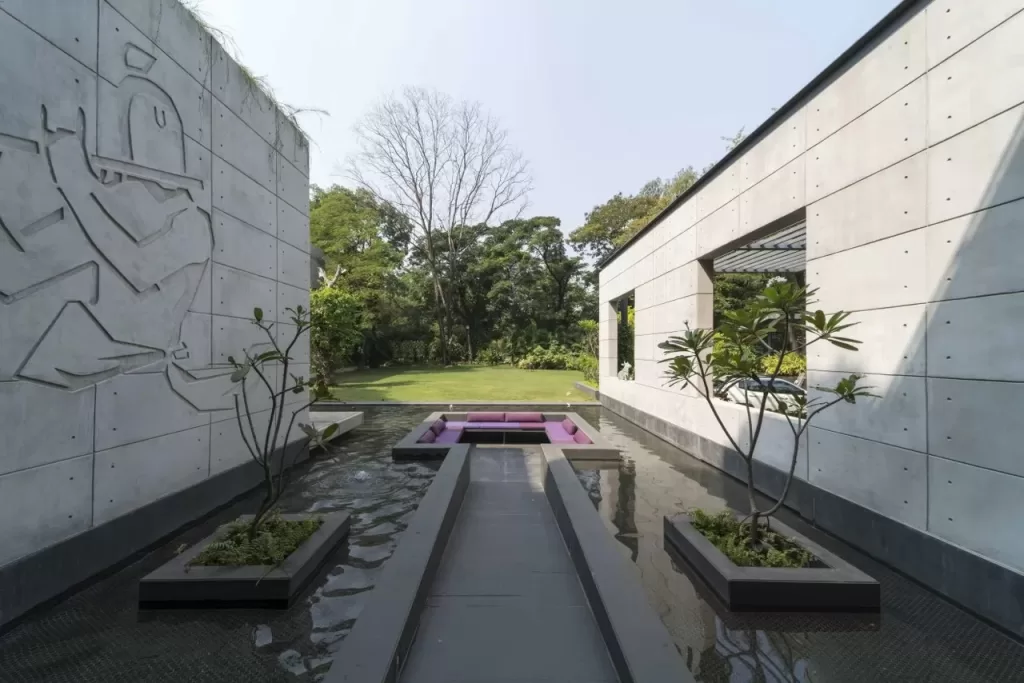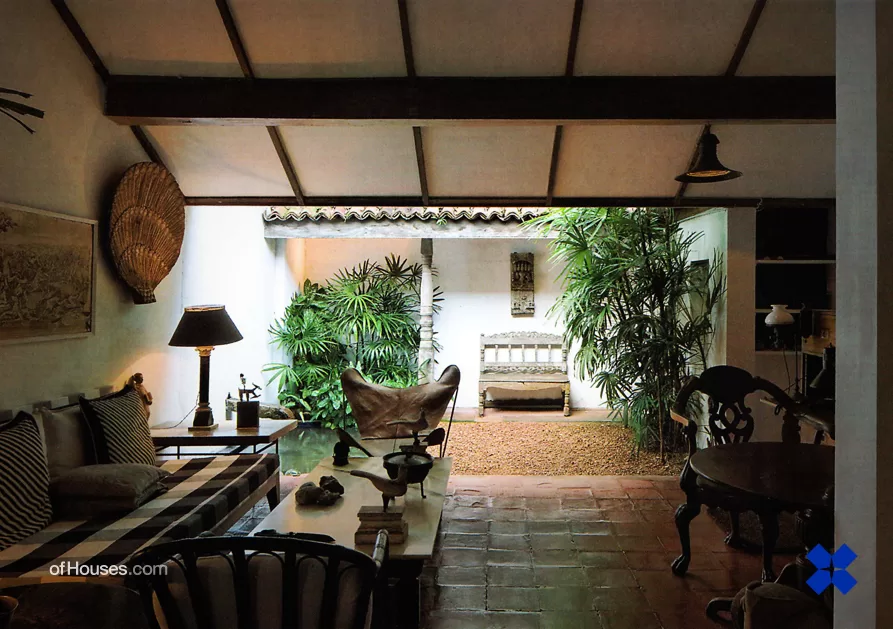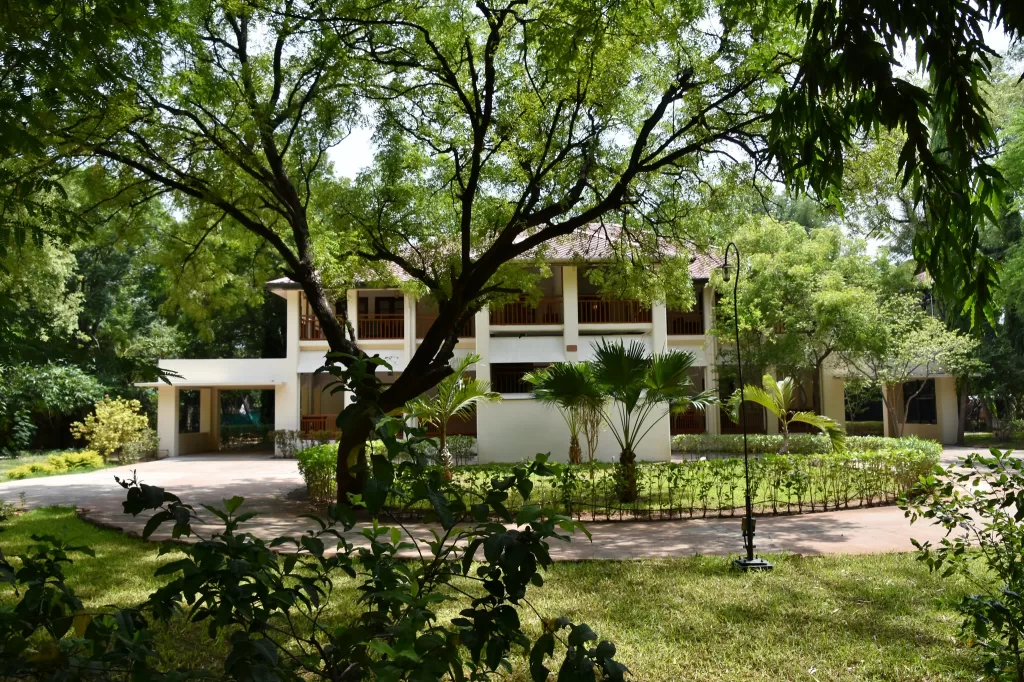12 Mar Tropical Modernism: Exploring the Timeless Architectural Era
Tropical Modernism, an architectural movement that emerged in the mid-20th century, represents a unique blend of modernist principles and tropical environments. It is a design approach that celebrates the harmony between nature and built structures, creating spaces that are not only aesthetically pleasing but also functional in tropical climates. This article will delve into the key features of Tropical Modernism, and its evolution from modernism, and explore notable examples, focusing on the work of Geoffrey Bawa and two detailed case studies in India.

What is Tropical Modernism:
Tropical Modernism is an architectural style that emphasizes the integration of buildings with their natural surroundings, taking into account the specific climate, vegetation, and topography of tropical regions. The movement seeks to create a symbiotic relationship between the built environment and nature, utilizing open spaces, natural ventilation, and indigenous materials. Key characteristics include flat roofs, expansive glass surfaces, and the use of local materials to ensure sustainability and a connection with the local culture.
Key Features of Tropical Modernist Architecture
Tropical Modernism is characterized by several key features that set it apart from traditional modernist architecture:
1. Natural Materials:

Tropical Modernism prioritizes sustainability. Architects use locally sourced materials to minimize environmental impact and connect with regional culture. Natural materials like wood, bamboo, and stone are used to blend in with the environment and provide thermal insulation. Materials are chosen based on climate, with good thermal mass for temperature regulation and humidity-resistant materials for tropical weather.
2. Natural Light and Ventilation:

Large, open spaces with ample natural light and ventilation are another hallmark of Tropical Modernism. It is often achieved through the strategic placement of openings, louvres, and large windows. This helps maximize airflow, mitigating the challenges posed by high temperatures and humidity in tropical regions. allowing residents to enjoy the tropical climate while minimizing the need for artificial cooling.
3. Open Spaces:

The use of open spaces, verandas, and balconies enhances the sense of openness and promotes cross-ventilation. These design elements contribute to a sense of spatial fluidity and connection with the tropical surroundings.
4. Incorporation of Local Design Elements:

Architects practising Tropical Modernism pay homage to local culture by incorporating traditional design elements, motifs, and architectural styles. This adds a layer of cultural richness to the design and fosters a sense of identity.
5. Integration with Nature:

Tropical Modernist designs blur the boundaries between indoor and outdoor spaces. Courtyards, terraces, and open pavilions create a seamless transition, allowing inhabitants to enjoy their natural surroundings. Additionally, the incorporation of landscaping elements is crucial. Tropical Modernist architecture often features lush gardens, water features, and greenery that complement the natural environment and contribute to a visually appealing and ecologically sustainable design.
6. Sustainable Technologies:

In tropical climates, passive cooling techniques may be used to reduce the reliance on energy-intensive cooling systems. Thermal mass, cross-ventilation, and natural shade are some examples of these techniques. Additionally, Tropical Modernist designs may incorporate rainwater harvesting systems to manage water resources efficiently in response to heavy rainfall.
Evolution of Modernism to Tropical Modernism

Tropical Modernism emerged as a response to the limitations of traditional modernist architecture in tropical regions. The modernist movement, which originated in Europe in the early 20th century, championed simplicity, functionality, and the use of new materials such as steel and glass. However, these design principles were not always suitable for tropical climates, where high temperatures, humidity, and heavy rainfall posed challenges.
Architects began to adapt modernist principles to create a more suitable architectural style for tropical regions, giving rise to Tropical Modernism. This new approach took into account the local climate, cultural context, and the need for sustainable design solutions. This evolution signifies a departure from the rigid confines of conventional modernist design, necessitating an approach that is adaptive, responsive, and inextricably linked to the nuances of tropical environments.
Architects like Geoffrey Bawa played a significant role in shaping the evolution of Tropical Modernism, blending traditional architectural elements with modernist principles to create a unique style that was both responsive to the environment and culturally appropriate.
Geoffrey Bawa and his influence on Tropical Modernism

Geoffrey Bawa, widely regarded as the father of Tropical Modernism, was a Sri Lankan architect who revolutionised the field with his innovative designs. Bawa’s understanding of local culture and the tropical climate of Sri Lanka deeply influenced his work. He believed in creating architecture that was not only functional but also evoked an emotional response from its users.
Bawa was an architect known for his deep appreciation for the environment and local culture and a desire to create spaces that promoted a sense of tranquillity and connection with nature. His unique approach to architecture involved using modernist principles and adapting them to the specific needs of the tropics, resulting in designs that were both functional and aesthetically pleasing. Bawa’s designs were known to incorporate both indoor and outdoor spaces, with lush gardens and courtyards becoming integral parts of his buildings. Additionally, he used natural materials such as timber and stone, which added warmth and character to his structures.
Bawa’s most famous works, including the Kandalama Hotel and the Lunuganga Estate, showcased his brilliance in Tropical Modernism, and brought international recognition to this architectural style.
Lunuganga Estate case study

The Lunuganga Estate, located in Bentota, Sri Lanka, is a prime example of Geoffrey Bawa’s mastery of Tropical Modernism. Originally a rubber plantation, Bawa transformed the estate into a stunning garden retreat and his residence. The estate features a series of interconnected buildings, courtyards, and gardens that harmonize with the natural landscape.
Bawa’s design for the Lunuganga Estate integrated traditional architectural elements, such as verandas and courtyards, with modernist principles. The buildings are designed to capture cooling breezes, with open, airy spaces that provide a sense of connection to the surrounding nature. The estate’s lush gardens, complete with water features and sculptures, create a serene environment that perfectly complements the architecture.
The Lunuganga Estate served as a canvas for Bawa’s continual experimentation and evolution as an architect. Over the years, he added and modified structures, always adapting to the changing needs of the environment and his own evolving design philosophy.
Tropical Modernism in India
Tropical Modernism has also made its mark in India, where architects have embraced design principles to create stunning examples of tropical architecture. The country’s diverse climate and rich architectural heritage provide fertile ground for the exploration of Tropical Modernism.
Let’s explore three case studies that showcase the application of Tropical Modernism in India.
Case Study 1: Heritage Madurai (Formerly Madura Club)

Location: Madurai, Tamil Nadu, India
Original Architect: Geoffrey Bawa (1974)
Restoration Architect: Vinod Jayasinghe
Current Use: Luxury Heritage Resort
Design Principles:
1. Integration with Nature:
The low-rise structure is designed to seamlessly blend with the existing landscape, incorporating mature banyan trees into the plan. Open courtyards, landscaped gardens, and water features create a seamless connection between the built environment and nature.
2. Courtyards and Open Spaces:
The use of courtyards and open walkways allows for natural ventilation and light, reducing dependence on artificial cooling. The central courtyards provide natural ventilation and a serene ambience. The courtyards also serve as focal points, bringing daylight into the heart of the building.
3. Local Materials:
Consistent with Tropical Modernist principles, Bawa utilised locally sourced materials like brick, stone, granite, and timber to create a sense of harmony with the regional aesthetic. Traditional Madurai stone, with its distinctive warm hue, was employed for flooring and cladding, contributing to a sense of regional identity.
4. Fusion of Styles:
The design incorporates elements of both Asian and European architecture, reflecting Bawa’s signature “Tropical Modernist” style.
Why it’s Tropical Modernist:
1. Climate Responsiveness:
The design prioritizes natural ventilation, passive cooling, and integration with the existing vegetation, making it well-suited to the hot and humid climate of Madurai.
2. Cultural Context:
Bawa’s design reflects a deep understanding of Madurai’s cultural context. The use of local materials and the incorporation of courtyards, a traditional Indian architectural element, demonstrate respect for the local context. 18th-century columns, antique doors and traditional motifs, reminiscent of the city’s temples, adorn the architectural elements, creating a harmonious dialogue between the old and the new.
Additional Points of Interest:
- The restoration by Vinod Jayasinghe, a disciple of Bawa, aimed to preserve the original design while incorporating modern amenities and creating a luxurious resort experience.
- The property’s transformation from a private club to a public resort has contributed to the preservation of its architectural heritage while making it accessible to a wider audience.
Bawa’s design is considered one of his best and exemplifies the principles of Tropical Modernism by creating a space that is both aesthetically pleasing and functionally responsive to its environment and cultural context.
Case Study 2: The Skew House, Kerala

Location: Malappuram district, Kerala, India
Architect: Thought Parallels Architecture (Shabna and Nikhil Mohan)
Date of Completion: 2018
Design Principles:
- Modern Tropical Design: The Skew House blends contemporary design elements with traditional Kerala architecture, creating a unique and functional space.
- Response to Site: The house is nestled amidst a rubber plantation, with its orientation and layout carefully considered to respect the natural environment and existing vegetation.
- Separation of Public and Private Spaces: The design features two distinct blocks, one for the family and another for guests, connected by a semi-private living area.
- Sustainable Materials: Locally sourced and low-impact materials like brick, wood, and natural stone are used throughout the construction.
Why it’s Tropical Modernist:
- Climate Responsiveness: The design prioritizes natural ventilation and light with features like open living spaces, large windows, and strategically placed courtyards.
- Integration with Nature: The use of local materials, the connection to the surrounding landscape, and the focus on natural light and ventilation are all hallmarks of Tropical Modernism.
- Respect for Tradition: The incorporation of a prayer room oriented towards a specific direction acknowledges the cultural context and religious beliefs of the homeowners.
Additional Points of Interest:
- The name “Skew House” comes from the angled design of the guest block, which was necessary to accommodate the prayer room’s orientation.
- The minimalist aesthetic and focus on functionality echo the core principles of modern architecture.
The Skew House showcases how contemporary design can coexist with and even enhance the surrounding natural environment.
Overall, The Skew House exemplifies Tropical Modernism by combining modern design elements with respect for local context, culture, and sustainability.
The Future of Tropical Modernism in India
Tropical Modernism has gained popularity in India as architects recognise the need to create sustainable, functional, and aesthetically pleasing spaces. As the country continues to urbanise and grapple with the challenges of climate change, Tropical Modernism offers a viable solution to be responsive to the local environment.
The future of Tropical Modernism in India lies in its ability to evolve and adapt to changing needs and contexts. Architects will need to continue exploring innovative design solutions that respond to the unique climatic conditions of different regions in India. Furthermore, incorporating traditional architectural elements and techniques can help create a sense of identity and cultural continuity in Tropical Modernist designs.
Challenges and Criticism of Tropical Modernism
While Tropical Modernism offers many advantages, it is not without its challenges and criticisms. One of the main challenges is the maintenance and upkeep of buildings in tropical climates. The harsh weather conditions, including heavy rainfall and high humidity, can cause rapid deterioration of materials and require regular maintenance.
Critics argue that Tropical Modernism can sometimes result in buildings that are too open and exposed to the elements. This leads to issues with privacy and security. Additionally, the use of natural materials may not always be cost-effective or readily available, posing challenges for architects and homeowners.
Conclusion
Tropical Modernism is a design approach that celebrates the harmony between nature and built structures in tropical regions. It seamlessly combines modernist principles with the unique climatic conditions of these areas. Thus, it creates spaces that are not only aesthetically pleasing but also functional and sustainable.
Architects like Geoffrey Bawa played a significant role in shaping Tropical Modernism, with their innovative designs and deep understanding of the local context. In India, Tropical Modernism has gained traction, as architects embrace its principles to create stunning examples of tropical architecture.
As the country continues to embrace sustainable design, Tropical Modernism offers a promising path forward. By integrating traditional architecture, exploring innovative solutions, and adapting to needs and contexts, Tropical Modernism continue to thrive and shape the future of Indian architecture
Content Writing And Research By: Ar. Kiran Rathi
The post Tropical Modernism: Exploring the Timeless Architectural Era appeared first on The Architects Diary.




binance
Posted at 02:50h, 17 DecemberCan you be more specific about the content of your article? After reading it, I still have some doubts. Hope you can help me. https://accounts.binance.com/en-IN/register?ref=UM6SMJM3